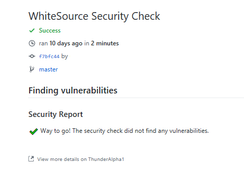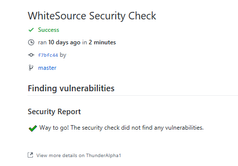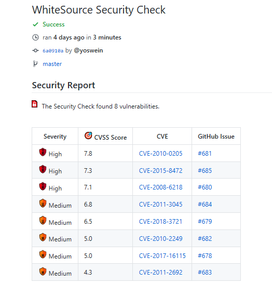...
| Table of Contents | ||
|---|---|---|
|
...
For more information or questions on WhiteSource Bolt for GitHub, please reach out directly to boltgithub@whitesourcesoftware.com.
| Info |
|---|
Before you begin, note the following:
|
...
Parameter | Type | Description | Required | Default |
|---|---|---|---|---|
minSeverityLevel | String | Enables users to decide whether to open a new GitHub Issue only if a certain Severity Level is available. Available values for "minSeverityLevel" needs to be:
| No | LOW |
Initiating a Scan
New users are entitled to scan each repository up to five times a day. Existing WhiteSource customers have the scan limitations that are set in their account agreement with WhiteSource.
A scan is initiated via a valid GitHub 'push' command. A valid 'push' command meets at least one of the following requirements:
One of the commits in the 'push' command include added file(s) that have an extension supported by WhiteSource and/or one of the commits in the 'push' command included a removal of file(s) that have an extension supported by WhiteSource. Refer to the WhiteSource Languages page in order to find out whether or not a specific language and its extensions are supported.
One of the commits in the 'push' command includes a modification in the package manager configuration file(s). This includes any of the following files:
build.gradle
pom.xml
setup.py
requirements.txt
Gemfile.lock
package.json
bower.json
Gopkg.lock
Godeps.lock
vendor.conf
gogradle.lock
glide.lock
composer.json
build.sbt
paket.dependencies
Any metafile with one of the following extensions:
config
csproj
htm
html
shtml
xhtml
jsp
asp
do
aspx
...
Initiating a Merge Policy
A merge policy utilizes the app's integration with GitHub Checks API. It enables the repository's administrator to approve the merging of a pull request with 'Failed' commit statuses to a target branch in the repository.
For more information on Checks API, see the related GitHub Checks API introduction page.
Prerequisite for the Merge Policy: Add a Branch Protection Rule
...
When the parameter 'vulnerable.check.run.conclusion.level' is set to 'success' or 'failure' (default), and a 'success' status is provided for the scan, since no vulnerabilities were found and no errors occurred during the scan for this head commit. In this case, the merging of a pull request that includes this commit to another branch in the repository is automatically approved.
When the parameter 'vulnerable.check.run.conclusion.level' is set to 'success'. In this configuration, even a 'failed' status for a head commit's scan is converted to 'success'. The following screenshot displays a 'success' indicator for a commit that includes high severity vulnerabilities, since the parameter 'vulnerable.check.run.conclusion.level' is set to 'success'. In this case, the merging of a pull request that includes this head commit to another branch in the repository is automatically approved.
The following screenshot displays a 'success' indicator for a commit that includes an error that occurred during the scan, since the parameter 'vulnerable.check.run.conclusion.level' is set to 'success'. In this case, the merging of a pull request that includes this head commit to another branch in the repository is automatically approved.
...
Go to the 'Applications' section of your GitHub's account settings, and click on the 'Configure' button next to the 'WhiteSource Bolt for GitHub' app.
The 'WhiteSource Bolt for GitHub' page opens. Scroll down in order to view the 'Uninstall WhiteSource Bolt for GitHub' button.
Click on the 'Uninstall' button. Uninstalling WhiteSource Bolt for GitHub removes it from all your repositories.
Optionally, go to 'Authorized GitHub apps' tab, and click the 'Revoke' button next to the 'Bolt for GitHub' app.





